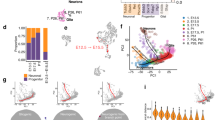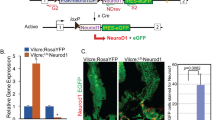Abstract
RECENT work from this laboratory has documented the initial expression of the noradrenergic phenotype in autonomie neuroblasts of the rat embryo in vivo. Tyrosine hydroxylase (T-OH) (rate-limiting enzyme in catecholamine biosynthesis)1, dopamine-β-hydroxylase (DBH) (which converts dopamine to noradrenaline) and the catecholamine (CA) transmitters appear simultaneously in sympathetic ganglion primordia at 11.5 days of gestation2,3. In addition, these noradrenergic characters transiently appear in a population of presumptive neuroblasts within the primitive gut mesenchyme2,3. The noradrenergic gut neuroblasts appear at 11 .5 days and increase in numbers over the ensuing 24 hours. Subsequently, however, numbers decrease progressively so that by 14.5 days of gestation virtually no cells exhibiting noradrenergic traits are detectable2,3. Elucidation of the fate of these neuroblasts may help define mechanisms influencing neuronal phenotypic expression and/or the factors which govern selective neuronal death during ontogeny. In this report we show that treatment with the trophic protein macromolecule, nerve growth factor (NGF), increases the number of catecholamine (CA)-fluorescent cells and delays the ontogenetic disappearance of CA from the gut.
This is a preview of subscription content, access via your institution
Access options
Subscribe to this journal
Receive 51 print issues and online access
$199.00 per year
only $3.90 per issue
Buy this article
- Purchase on Springer Link
- Instant access to full article PDF
Prices may be subject to local taxes which are calculated during checkout
Similar content being viewed by others
References
Levitt, M., Specter, S., Sjoerdsma, A. & Udenfriend, S. J. Pharmac. exp. Ther. 148, 1–8 (1965).
Cochard, P., Goldstein, M. & Black, I. B. Proc. natn. Acad. Sci. U.S.A. 75, 2986–2990 (1978).
Cochard, P., Goldstein, M. & Black, I. B. Devl Biol. (in the press).
Mobley, W. C., Server, A. C., Ishii, D. N., Riopelle, R. J. & Shooter, E. M. New Engl. J. Med. 297, 1096–1104 (1977).
Zaimis, E. (ed.) Nerve Growth Factor and its Antiserum (Athlone. London, 1972).
Levi-Montalcini, R. & Angeletti, P. U. Pharmac. Rev. 18, 619–628 (1966).
Levi-Montalcini, R. & Booker, B. Proc. natn. Acad. Sci. U.S.A. 46, 384–391 (1960).
Mobley, W. C., Schenker, A. & Shooter, E. M. Biochemistry 15, 5543–5551 (1976).
Kessler, I. A. & Black, I. B. Brain Res. (in the press).
Falck, B. & Owman, C. Acta Univ. Lund Sec. II, No. 7 (1965).
Coughlin, M., Boyer, D. & Black, I. B. Proc. natn. Acad. Sci. U.S.A. 74, 3438–3442 (1977).
Hendry, I. A. J. Neurocytol. 6, 299–309 (1972).
Levi-Montalcini, R. & Angeletti, P. U. Physiol. Rev. 48, 534–569 (1968).
Chun, L. L. & Patterson, P. H. J. Cell Biol. 75, 694–704 (1977).
Chun, L. L. & Patterson, P. H. J. Cell Biol. 75, 712–718 (1977).
Hill, C. E. & Hendry, I. A. Neuroscience 2, 741–749 (1977).
Thoenen, H., Angeletti, P. U., Levi-Montalcini, R. & Kettler, R. Proc. natn. Acad. Sci. U.S.A. 68, 1598–1602 (1971).
Author information
Authors and Affiliations
Rights and permissions
About this article
Cite this article
KESSLER, J., COCHARD, P. & BLACK, I. Nerve growth factor alters the fate of embryonic neuroblasts. Nature 280, 141–142 (1979). https://doi.org/10.1038/280141a0
Received:
Accepted:
Published:
Issue Date:
DOI: https://doi.org/10.1038/280141a0
Comments
By submitting a comment you agree to abide by our Terms and Community Guidelines. If you find something abusive or that does not comply with our terms or guidelines please flag it as inappropriate.



